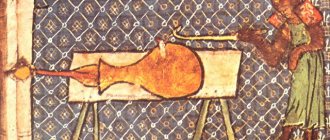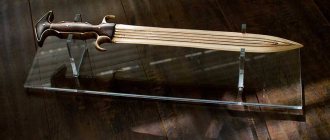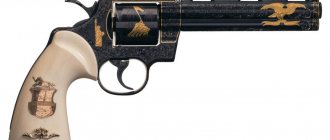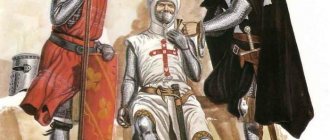It is known that swords made from a variety of alloys were used in military campaigns, as well as special historical missions.
Future heroes were taught to wield bladed weapons of various shapes, sizes and degrees of sharpness from a young age. The best sword masters became legendary warriors, the epics about which are still studied in school.
Some of the famous swords were lost or destroyed, while others survive to this day in museums or private collections.
Let's take a look at 10 legendary swords whose powerful stories still inspire awe and respect.
Sword of Mercy - Curtana
The famous weapon owned by one of the last Anglo-Saxon kings of England, Edward the Confessor. His reign occurred at the beginning of the eleventh century. After the death of Edward the Confessor, the tip of the blade was broken off from the Sword of Mercy. In 1236 he was given the name Curtana, which translated meant shortened.
The reason for the damage to the product is unknown, but according to myth, the tip of the sword was torn off by an angel.
In those days, using this sword was considered a great honor. And it was used for royal ceremonies, which was considered a gesture of mercy. The sword is one of the very rare specimens that were able to survive the reign of Oliver Cromwell. And he was famous for ordering all metal weapons to be melted down into scrap.
Sword of Mercy - Curtana
The Sword of Mercy is part of the Jewels of the United Kingdom of Great Britain and is used for the coronation of British monarchs. The blade is also used to knight worthy people.
Strider
Ninjas have always had the latest technology. Each ninja has his own tastes and preferences. You are an elite killer, and therefore using some kind of daggers or throwing weapons is no longer comme il faut. But making a weapon according to a different design (without destroying the old one) is quite normal. Hiryu Strider's weapon is something that is not particularly clear, but if possible it is still a sword.
Well, it seems immediately obvious that you can’t use it that way.
He will hurt himself. An arm or a leg, with any swing. His fingers are not protected, but they are always being targeted. Even when they are protected. The weight of the blade can technically be supported this way, but the movements will be very slow due to the weight. The most important thing is that this weapon makes no sense. In fact, by using it, he shortens his weapon by arm's length from elbow to hand. Those. The useful area of the sword is half the actual area. For what? Theoretically, you can use it like a regular sword, but as in any animation, the size of the sword and, as a result, its weight exceeds reasonable limits. It will be beyond the power of an ordinary person. Plus, it doesn’t have a guard or pommel, which means it will roll a lot when hit. In turn, this means that after the blow it will be extremely difficult to swing again - the hand will turn out. Simply put, after dodging one blow from such a rail, there will be time to come up and stab the hero with a penknife.
- Andrey
Medieval Tizona (TIZONA) and Colada (COLADA)
The excellent military leader and diplomat El Cid from the kingdom of Castile possessed the famous swords - Colada and Tizona. Today the swords are on display in a museum in Burgos (Spain). The poem The Lay of El Cid tells that Tison's sword frightened his enemies so much that they fainted in horror at the sight of it.
Rumor has it that Tizón was forged from Damascus steel in the city of Cordoba in Spain.
Size
The length of the sword is 103 cm
Weight
About 1.1 kg.
Inscriptions
The blade has two inscriptions, the year of its manufacture – 1002 and a Catholic prayer.
In 1516, the product was given by King Ferdinand to the Marquis de Fals. Over time, the sword, passed down by inheritance, was given to the military museum of Madrid. Then he moved to the Burgos Museum. There were a lot of versions about the origin of the sword, even going so far as to claim that it was a fake. The controversy continues to this day.
The Colada sword is less famous, but also has the status of historical value in Spain. Today, the owners of the blade are the Falces family of Spanish nobles. They are undoubtedly proud of this relic, despite the analysis of the metal, which showed a fake.
In 1516, Tizona was granted by King Ferdinand to the Marquis de Fals. Over time, the sword, passed down by inheritance, was given to the military museum of Madrid. Then he moved to the Burgos Museum. There were a lot of versions about the origin of the sword, even going so far as to claim that it was a fake. The controversy continues to this day.
The Colada sword is less famous, but also has the status of historical value in Spain. Today, the owners of the blade are the Falces family of Spanish nobles. They are undoubtedly proud of this relic, despite the analysis of the metal, which showed a fake.
Tisona
The weapon that belonged to the legendary Spanish hero Rodrigo Diaz de Vivar, better known as El Cid Campeador, is now located in the cathedral of the city of Burgos and is considered a national treasure of Spain.
After the death of Sid, the weapon went to the ancestors of the Spanish king Ferdinand II of Aragon, and the king who inherited it gave the relic to the Marquis de Falces. The descendants of the Marquis carefully preserved the artifact for hundreds of years, and in 1944, with their permission, the sword became part of the exhibition of the Royal Military Museum in Madrid. In 2007, the owner of the sword sold it to the authorities of the region of Castile and Leon for $2 million, and they transferred it to the cathedral where El Cid is buried.
Employees of the Ministry of Culture were offended by the sale of the sword, and they began to spread information that it was a later fake that had nothing to do with de Vivar. However, a thorough analysis confirmed that although the worn “native” hilt of the weapon was replaced with another in the 16th century, its blade was made in the 11th century, that is, the sword most likely belonged to the hero.
The famous Durandal
The fascinating history of the Durendal sword attracted monks to Rocamadour. Numerous pilgrims retold the story of Roland's sword from mouth to mouth. So the legend spread throughout Europe. The legend says that Roland, defending the chapel from the enemy, threw a magic blade at the building. The sword pierced the stonework and remained stuck in the wall.
The opinion of modern scientists is completely different. In the chapel there is a completely different product. In fact, Roland died on August 15, 778 in the Roncelvalles Gorge, which is quite far from Rocamadour. And the first mention of a sword in the wall appeared only in the 12th century, after the writing of a song about Roland.
Sword Durandal in the wall
Most likely, the monks associated the legend with the name of the hero to ensure a stable flow of pilgrims. Rejecting the ownership of the Durandal sword by Roland, contemporaries cannot offer anything in return. Whose sword this is remains a mystery. Durandal has now been removed from the wall and is in the Paris Museum of the Middle Ages.
Xenoblade Chronicles
It looks more like a keychain than a sword, as the huge hole in it is incredibly embarrassing. Very bright and neon. Killing your enemy with such a sword is like throwing him a cosmic party. But unlike many blades, it at least has a sharp part that can hit the enemy.
The handle narrows downwards and forms a cutting edge, which, when swung, will cut off the owner’s fingers. If it is made of steel it will weigh enormously, but if it is made of plastic, then what is the point? And yes, any holes in the blade are a weakening of the structure, which will quickly lead to failure. We are not into laser swords, this is not our profile at all.
- Andrey
Joyeuse - Joyful
Charlemagne was considered the owner of this legendary sword. He is considered the founder of the French and German monarchies. Charlemagne was also Emperor of the Romans, where he was known as Charles the First. Contemporaries identify two blades that could be precisely this weapon.
Its parts were made over several centuries; it is very difficult to determine their authenticity. The carved head of the handle is made of gold and is divided into two parts. The hilt of the Joyeuse sword has a date of manufacture that coincides with the years of Charles's life.
Sword Joyeuse – Joyful in different angles
One of the swords is in Vienna, and the other is in the Louvre. The copy kept in the Louvre is believed to be partly made from the original sword of Charlemagne. There are many legends about the sword; it is mentioned in Balfinch mythology. It tells how Charlemagne uses the sword to behead Corsublus. Today the blade is used for the coronation of French kings.
Joyeuse
Step-by-step plan for making money by setting up VKontakte advertising
Learn VKontakte advertising in 3 days and start earning money remotely from RUR 50,000. per month.
Sign up for training
The Joyeuse blade (translated from the French “joyeuse” - “joyful”), according to legend, belonged to the founder of the Holy Roman Empire, Charlemagne, and served him faithfully for many years. According to legend, he could change the color of the blade up to 30 times a day and outshine the Sun with its brightness. Currently, there are two blades that the famous monarch could wield.
Sword of Saint Peter
According to some statements, the Sword was made in the first century on the eastern border of the Roman Empire. But no one can prove this. There are only the words of those who believe in the authenticity of the blade. Legend has it that Saint Peter used this sword to cut off the ear of the assistant high priest.
According to English mythology, the sword of St. Peter traveled to England. But in 968, Bishop Jordan moved him to Poland. This product is considered a real relic; it was transported to the Archdiocese Museum in Poznan.
Sword of Saint Peter
Legacy of Kain
You are an immortal vampire who constantly varies between the statuses of “villain” and “anti-hero”. Your weapon is so important that it appears in every game in the series, and it has the ability to suck the life out of your opponent. It is also an excellent vessel for storing souls. His name is Soulriver.
It's funny, but Soulriver is relatively close to an adequate sword.
Essentially, this is a flamberge. Only if the angle of the bends is drawn too large, it will slide off the enemy and unwind left and right when striking due to the fact that the overall “width” of the blade is too large. If it had been a little narrower, it would have been a normal flamberge. This is about the blade. The gardaí, of course, spoils everything somewhat. If it is metal, it will obviously be too heavy and will upset the balance in the opposite direction, such and such a cast skull weighing half a kilogram. If it is made of bone or something else light, it will simply burst quickly and lose its beauty. The very form of the guard is a perversion, but generally acceptable. The main wings of the guard will fulfill their function. False guards (smaller wings) are simply not needed in this case. The false guard was used on two-handed swords, which had a ricasso - the unsharpened part of the blade - between the guard and the false guard. It was possible to grab the sword with one hand, while continuing to hold the handle with the other, and strike like a spear. This is called the half sword technique. There is no ricasso between the guard and the false guard, so it is not clear why it is needed.
- Andrey
Unusual Seven-Tooth Sword
The sword comes from the Land of the Rising Sun and was discovered in 1945 at a Shinto shrine in the Japanese city of Tenri. The product is very unusual in the usual understanding of edged weapons. The complex shape of the blade has six branches, like the branches of a tree. The seventh is the tip of the main blade.
To this day, the Seven-Toothed Sword has survived in very poor condition. But on the blade you can read the inscription, according to which the Chinese emperor received it as a gift from the ruler of Korea.
Unusual Seven-Tooth Sword
In the oldest work on the history of Japan, Nihon Shoki, there is a mention of a strange blade. According to legend, the product was presented to the semi-mythical Empress Jingu. Modern checks prove that this was a legendary artifact. But the ownerless storage of the sword for 1.5 thousand years made itself felt by its condition.
Kusanagi no Tsurugi
This mythical sword has been a symbol of the power of Japanese emperors for several centuries. Kusanagi no Tsurugi (translated from Japanese as “sword that mows grass”) is also known as Ame-nomurakumo no Tsurugi - “sword that collects the clouds of heaven.”
The Japanese epic says that the sword was found by the wind god Susanoo in the body of an eight-headed dragon he killed. Susanoo gave the blade to his sister, the sun goddess Amaterasu, later it ended up with her grandson Ninigi, and after some time it went to the demigod Jimmu, who then became the first emperor of the Land of the Rising Sun.
It is interesting that the Japanese authorities never put the sword on public display, but, on the contrary, tried to hide it away from prying eyes - even during coronations the sword was carried out wrapped in linen. It is believed to be kept at the Atsuta Shinto shrine in Nagoya, but there is no evidence of its existence.
The only ruler of Japan to publicly mention the sword was Emperor Hirohito: giving up the throne after the country's defeat in World War II, he called on the temple servants to keep the sword at all costs.
General's curved saber of San Martin
The famous Argentine general Jose de San Martin fought for the liberation of South America. He was hailed as a hero and the First Defender of Peru. Thanks to his actions, Peru gained independence on July 28, 1821. To this day, the order of the same name is considered the highest award in Peru.
One day, an experienced commander acquired a curved sword in London. San Martin immediately noted the item's suitability for combat. Following his example, he armed his army with curved swords. This greatly affected the effectiveness of combat.
Curved saber of the Argentine General San Martin
The crooked blade served San Martin until his death, and then it passed to the General of the Republic of Argentina, Don Juan Manuel de Rosas. In 1896, the saber was transferred to the Buenos Aires Museum, where they tried to steal it twice, but fortunately without success.
Final Fantasy 8
What if on the battlefield it would be possible not only to chop down the enemy, but also to shoot at him? Quite an interesting possibility, which is kind of real in the hands of Squall Leonhart from Final Fantasy. It's strange that such a weapon is capable of shooting at all.
Well, by the way, jokes are jokes, but this really happened.
Not quite like that, the blade cannot go anywhere (any movable structure is a risk of rapid breakage, the blade itself and the handle are one whole, the shank of the blade passes through the entire handle and unrivets there). It was just blowing from the side. Of course, the toy turned out to be of little use. First, one charge. Secondly, with a straight handle it is very difficult to aim, and if you make it curved, it is impossible to fencing. The option that is unrealistic in the game is precisely for the second point. The curved handle shifts the center of gravity of the blade, i.e. it will tend to turn inside out with each swing. Well, in fact, the shape of the blade is more suitable for a kitchen knife. Why mass at the base of the blade? Usually the part that is closer to the end is cut, it is not for nothing that the near part is sometimes not sharpened at all, leaving a ricasso. An example of a functional thickening is a falchion. There is a thickening at the end to enhance the slashing blow. This has its downsides, but at least it makes sense.
- Andrey
Knight Wallace's Sword
The mind-blowing story of Sir William Wallace will terrify modern man. But in those days, during the struggle for English independence, after the victory at Stirling Bridge, William Wallace covered the hilt of his blade with the skin of the treasurer. According to some statements, Wallace made a scabbard and sword belt from the same material.
The terrible facts of that time are difficult to refute today. The further fate of Wallace's sword was determined by King James IV. The sword has been redesigned and the finish has been replaced with a new one more suitable for the legendary sword.
Rumor has it that such bloodthirstiness for Sir William was invented by the British. The fighter for justice and independence of Scotland became a prominent figure in history.
Knight Wallace's Sword
Ame no Habakiri: Sword of the Storm God
This sword was used by the lord of storms, Susano-o, when killing the serpent Yamata no Orochi. The most common version of this story is found in the Kojiki (“Records of Ancient Affairs”).
While traveling, the storm god came across a couple grieving over the impending kidnapping of their daughter Kushinada-hime. The remaining seven daughters have already been kidnapped. The culprit was none other than the eight-headed snake Yamata no Orochi, who took his victims every year.
Susano-o agreed to kill the creature. He ordered the couple to make eight barrels of the strongest sake, surrounding them with eight gates. The serpent came and drank sake, and while he was distracted and trapped by the eight gates, Susano-o cut off all the heads and tails of the monster.
The most famous Masamune sword is Honjo Masamune
The famous Japanese sword master Masamune deserves the title of the best metallurgist in the world. The dates of his life are not known for certain, but he worked in the 12-13 centuries. The incredible quality and beauty of the craftsman's products have gained popularity over the centuries.
The most famous blade is considered to be Honjo Masamune . In 1939, the product was recognized as a national treasure of Japan. Over the centuries it was passed down from one shogun to another. The owner of the collection, Tokugawa Iemasa, handed over several swords to the police in 1945, including Honjo Masamune.
Beautiful products of master Masamune
Further, in January 1946, the police handed over the swords to the US Army. But since then the history of the products has lost track. The famous Honjo Masamune is one of the historical artifacts lost after World War II.
Bloodthirsty Blades of Muramasa
Muramasa was a famous Japanese swordsman and blacksmith who lived in the 16th century. According to legend, Muramasa prayed to the gods to imbue his blades with bloodthirstiness and destructive power. The master made very good swords, and the gods respected his request, placing a demonic spirit of extermination of all living things in each blade.
It is believed that if the Muramasa sword gathers dust for a long time without use, it can provoke the owner to commit murder or suicide in order to “drink” blood in this way. There are countless stories of Muramasa sword wielders who went crazy or slaughtered many people. After a series of accidents and murders that occurred in the family of the famous shogun Tokugawa Ieyasu, which popular rumor associated with Muramasa's curse, the government outlawed the master's blades, and most of them were destroyed.
To be fair, it must be said that the Muramasa school is an entire dynasty of gunsmiths that lasted for about a century, so the story of the “demonic spirit of bloodthirstiness” embedded in swords is nothing more than a legend. The curse of the blades made by the masters of the school was, paradoxically as it may sound, their exceptional quality. Many experienced warriors preferred them to other swords and, apparently, thanks to their art and the sharpness of Muramasa’s blades, they won victories more often than others.
Napoleon's sword
The political and military leader of France, Napoleon Bonaparte, was proclaimed emperor in 1804. Everyone knows the wars with Europe under his leadership at the beginning of the 19th century. France received the status of the dominant empire. But the hero ended in exile on the island of Elba. And then his flight, and death in custody on the island of St. Helena.
Napoleon had a large collection of weapons, but his indispensable attributes on the battlefield were a pistol and a sword. The products were one of a kind and truly considered works of art. Already in the modern world, a sword that belonged to Napoleon was sold at auction for 6.4 million dollars.
It is known that the famous sword was given by Napoleon to his brother as a wedding gift. And then it was passed down from generation to generation and never left the Bonaparte family. Today it has the status of a national treasure of France.
Beautiful Napoleon Sword
Eternal Sonata
I wish I could play the blues when I fight. Or a victory melody after the enemy is defeated. Yes please. Trumpet+sword=Victory! With such a weapon, you are not only a fighter, but also the guy who in films with a flag stands in front of the army and blows a trumpet, after which the battle begins. And instead of being trampled by your own friends, you run with them.
In general, this is a form of khopesh. Only disproportionately large and heavy. Reduce it by four times - there will be a weapon. Obsolete, however, dating back to ancient times. Will parts of the pipe interfere in this case? Hard to tell. If the tubes are light, then they shouldn’t interfere much. But the benefits are also not visible. If they have any weight, then, again, they will interfere with balance and make the weapon heavier. Khopish is a very fast blade, its whole essence is speed. Any extra gadgets can cost your life.
- Andrey
The legendary blade of King Arthur - Excalibur
The first mention of Arthur's sword occurs in the Chronicle of the History of the Kings of Britain. The blade is assigned magical and magical properties. King Arthur managed to get this miraculous sword from the Lady of the Lake. The sheath of which contributed to the healing of wounds.
A conspiracy arose in the palace; Arthur's sister decided to kill him. For these purposes, she stole the Excalibur sword along with its scabbard and persuaded her lover Accolon to kill the king. Arthur had to defend himself with conventional weapons and was mortally wounded. The Knights of the Round Table returned Arthur's sword back to the pond from where it had been received.
Mythical product of King Arthur
According to another version, Excalibur was forged by the blacksmith god Volund. According to another, the sword was made in Avalon. And according to even earlier texts, the previous owner of the sword was Gawain, and only then did it fall into the hands of Arthur.
Garpa: the sword that killed Medusa
This Greek weapon had several owners: Kronos, Zeus and Perseus. It was a short, curved blade with a crescent-shaped protrusion that was originally used by Kronos. To kill his father Uranus, on the orders of Gaia, for his cruelty.
The same thing will happen with the next generation of gods: Kronos ate all his children except the youngest, Zeus. Zeus's mother Rhea secretly gave birth to him and placed a stone in his swaddling cloth. Cronus ate the stone, and in some versions of the story, Zeus used Garpa. To cut open Kronos' belly and free his five siblings. Who became Olympian deities. Meanwhile, Kronos and the other titans were cast into Tartarus.
Later, Zeus' son Perseus took Garpa and, after tracking down the Gorgon Medusa, beheaded the monster with this legendary sword. Some sculptures depicted Garpa as a straight sword with a crescent-shaped protrusion.
Japanese sword by Tomoyuki Yamashita
The general of the Japanese Imperial Army, Tomoyuki Yamashita, received the nickname “Malayan Tiger” during World War II for the conquest of the British colonies of Malaya and Singapore. But after the end of the war he was convicted of war crimes.
Tomoyuki Yamashita's sword in the museum
Throughout his military career, Tomoyuki Yamashita never parted with a sword made by the famous master Fujiwara Kanenaga. The date of manufacture of the blade is approximately 1640 - 1680. The sword underwent some changes at the beginning of the 20th century. After the war, Tomoyuki Yamashita's weapons were transferred to the military museum in West Point.
Monster Hunter 3
A huge sword that was most likely made from a dragon's finger (there are some kind of scales at the beginning, and at the end there is something very similar to a claw). Even if I wanted to, I would hardly be able to fight even with a cardboard sword of that size; it seems too cumbersome to me.
A common problem with any weapon with spikes on the blade is that they will simply pierce and stop the slash.
Obviously, there is no sharpening between the “fangs” (otherwise they would not have a round shape, there should be an expansion at the base of the fangs), therefore they cannot cut the enemy, only pierce them with a thorn. What's the point then? It's easier to take a spear if you need piercing blows. There is a cutting edge at the very end, but relative to the weight and size of the sword it is too small. The weapon, again, turns out to be meaningless. The second thing is, as often happens in games, the lack of a top. The pommel is needed for two reasons. Firstly, so that the handle does not slip out of your hand. Secondly, it has a decent weight and balances the weapon together with the guard, so that during a strike and subsequent swing the sword does not twist out of the hand. Without a balancing pommel and guard, even a relatively light sword will be extremely, extremely inconvenient for fencing. The exception is a very light weapon such as a checker. With all that it implies: it can only be used to chop, a checker is not a fencing weapon and is not suitable for defensive movements. Only attackers, and preferably from horseback. Despite the fact that it weighs only about a kilogram.
- Andrey
Ancient sword Zulfiqar
The history of Zulfiqar begins in ancient times. The ruler of the Islamic Caliphate, Ali, was the brother and son-in-law of the Prophet Muhammad. According to historical records, Muhammad was amazed by the power and strength of Ali in battle. And he decided to give him the sword Zulfiqar, which was a symbol of the Muslim faith.
The sword belongs to the scimitars - a saber with a curved blade. Such blades are characteristic of western and southern Asia. According to legend, Zulfiqar Ali used the sword during the siege of the city of Medina. In modern times, there are two images of the sword.
Some of them have two parallel blades, which increases its mythical abilities. Other images show a forked blade. According to some sources, the sword Zulfiqar still exists in the possession of Imam Muhammad al-Mahdi.
Work of art – Zulfiqar
Dark Souls
One of the Dark Souls swords looks very unusual. And the point is probably that the sword is an amputated part of the body of a woman with the body of a spider. God, I wouldn't fight with this.
There’s not even much to talk about here, it’s not even a sword. There is no cutting edge; upon contact with an enemy, it will simply be pierced by spikes and thrown away. Plus the weight, the danger of impaling yourself on the spikes at the guard, and, again, the same thing as in 99% of such cases - the lack of meaning in the design. It obviously slows down the swordsman's movements, so why is it needed? In fact, those swords that actually existed and which seem simple and uninteresting to everyone are real masterpieces. Their form is perfection, which was achieved not for the sake of beauty, but in order to survive in battle. Anything that is at least somehow different from “blade, guard, pommel” and at the same time does not have a narrow specialization is nonsense.
- Andrey
Excalibur
Probably everyone has heard about the legendary Excalibur of King Arthur. It could not be broken, and the scabbard gave the owner invulnerability.
Excalibur's name probably comes from the Welsh "Caledwulch", which can be translated as "heavily striking". It is first mentioned in the Welsh epic Mabinogion (11th century). According to one version, the name came from the Latin “chalybs” - steel, and the prefix “exc” meant enhanced properties.
According to one legend, Arthur pulled Excalibur from the stone, thereby proving his right to be king, but in most texts, he received it from the fairy of the lake after he broke his first sword. Before his death, he ordered it to be returned to its rightful owner, throwing it into the water.
There is definitely a historical prototype behind the myth of Excalibur, as well as behind the figure of King Arthur. Only this is not a specific weapon, but a tradition. For example, the custom of drowning weapons in Northern and Western Europe. Strabo describes such a ritual among the Celts in the vicinity of Toulouse, archaeological excavations in Thorsbjerg indicate the presence of such a tradition in Jutland (weapons date back to 60 - 200 AD).
Let's talk about the knight's sword
The functions of the sword included not only military affairs, they were often used for ritual processes. The ritual of knighting a young warrior, he was lightly tapped on the shoulders with a special sword. And the swords themselves were blessed by the priests. Sacred inscriptions and symbols were applied to the blades so that the bearer of the sword would protect Christianity from heretics and infidels.
Privileges of chivalry
The emergence of the feudal system is closely related to chivalry. Religious influence put the knight on the same level as the noble class.
They were given land, and in return they were required to join the army. And perform horse service. But in general, a person received the most valuable thing - freedom.
Thus, a knightly army was created. To obtain the title, training began from childhood. By the age of 12, the child became a squire. And by the time he reached adulthood, he was knighted.
Knighting.
Shcherbets
The coronation sword of the Polish monarchs, Szczerbiec, according to legend, was given to Prince Borislav the Brave (995-1025) by an angel. And Borislav almost immediately managed to put a notch on it, hitting the Golden Gate of Kyiv. This is where the name “Shcherbets” came from. True, this event is unlikely, since Borislav’s campaign against Rus' took place before the actual construction of the Golden Gate in 1037. If only he managed to put a notch, encroaching on the wooden gates of Tsar Grad.
In general, the “Shcherbets” that has survived to this day, according to experts, was made in the 12th-13th centuries. Perhaps the original sword disappeared along with the rest of Poland's treasures - the spear of St. Mauritius and the golden diadem of the German emperor Otto III.
Historical sources claim that the sword was used in coronations from 1320 to 1764, when it was used to crown the last Polish king, Stanisław August Poniatowski. After long wanderings from one collector to another, Szczerbiec returned to Poland in 1959. Today it can be seen in the Krakow Museum.
Final Fantasy 10
Let's just imagine that this weapon is out of the water. I don't know what to consider as a part that should cause damage to the enemy. Most likely, this is that small blade on the sword, which is like a separate sword. Horrible, to be honest.
We have already looked at this type. No pommel = no balance, clearly too much weight. Well, specifically here - an incomprehensible curl at the end, unnecessarily weighing down an already disproportionate thing, and also interfering with a penetrating stabbing blow. What's the point of sharpening for an injection, and then immediately widening it incomprehensibly? The flourish just doesn't make sense, and the sword itself is a typical Japanese "sleeper". As I already said, after one blow like this, until the second swing, you can approach the fighter even with a nail, there’s enough time to plug it up.
- Andrey
Second run on SoulCalibur
Another sword from the famous console fighting game, which has a very strange shape and... an eye in the middle. He looks at the fighter when he fights with part of him... Is this even interesting? Maybe it’s not a sword at all, but some kind of creature? Can you fight with this? I think no.
It is permissible to weld different types of steel, as, for example, in Damascus. You won't be able to solder steel to anything else. Especially with the flesh. You can’t make a blade nailed to a tree and call it a sword. You can, of course, cut the blades into a wooden base, but such a sword will not last long. A conventional example would be the Aztec “sword,” when sharp stone plates were cut into a piece of wood. But there they worked on the tender meat; when they meet the armor, such a thing will fall apart in an instant. Not to mention a collision with another blade made of normal steel.
- Andrey
Kingdom Hearts
Here he is. The real “Key to a girl’s heart.” Massive and made, in any case, of steel, instead of being a sword, it is rather a club. It's just that in the game it's positioned as a sword. Is it even possible to fight someone with such a machine?
It would be possible to fight with them if the arcs were turned in other directions. That is, they would be to the left and to the right of the grip. And here they are from above and below - how can you take it with your hand? It's not even about the size of the hand, but about how the blow is delivered. The upper arc, upon impact, would rest against his wrist, preventing him from completing the movement.
- Andrey
Once again Final Fantasy 10
The Final Fantasy series is ready to surprise us with silly swords and hairstyles too. It looks like a two-handed sword, which it is, and the part in the middle looks a lot like a steel scarab. However, I don’t know for sure whether something like this can be used in battle.
There is no pommel, weight - I’m not even talking about that anymore. As for the guard, there is something imitating it, but it is bent inward. This means that when the enemy hits, his blade will not be stopped, but will slide further, straight into its target. Well, bifurcation weakens the structure. If we consider the width of the sword to be more or less normal, then the halves will simply chip off quickly. Well, and, in fact, a complete lack of ergonomics of impacts. It’s not clear how to cut them at all. If it’s like a scimitar, from the inside bend, then it’s easier to take a scimitar that weighs fifteen times less.
- Andrey











